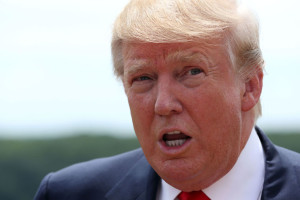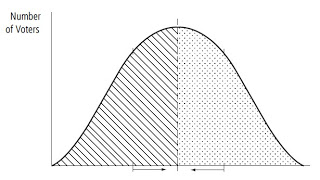Trump, the Unavoidable: Is Political Polarization Destroying Democracy?

The hurricane named Donald Trump has taken everyone by surprise by going against all the established rules in politics. So far, candidates were always trying hard to avoid taking extreme positions; aiming for the center of the political spectrum was seen as the way to win, and it worked. But Trump has taken exactly the opposite strategy, always aiming to positions that not long ago would have been seen as extreme and even unspeakable.
But he is having success. How can that be? For everything that exists, there must be reasons for it to exist, and this universal rule must be valid also for Donald Trump. And, indeed, the rise of Trump should be seen not only as having reasons to exist, but even as unavoidable. Let me try to explain why.
In 1929, Harold Hotelling developed a model of spatial competition among firms that today is still well known and takes his name. The idea is sometimes described in terms of what the best location for selling ice cream on a beach.Assuming that customers are distributed evenly along a linear beach, it turns out that the best position for all of them is to cluster exactly at the center. Something similar holds in politics: it is called the Hotelling-Downs model. It says that, in a political competition, the most advantageous position is at the center. This is a well known and traditional political strategy; those who are at the center win elections.
So, did Donald Trump disprove the Hotelling-Downs model with his strategy based on taking extreme position? No, but all models work only within the limits of the assumptions that produced them. If the assumptions change, then the models change as well. The Hotelling-Downs model, as it is commonly described, works on the assumption that voters’ preferences tend to cluster in the middle of the spectrum of political views, something like this
(image from Pew research center)
You see how the preferences among American voters are splitting into two halves. Liberals and conservatives are becoming more and more different, a split that may increase in the future. In a previous post of mine, I interpreted this trend as the result of the growing impoverishment of society, a phenomenon that increases the competition for the remaining resources. The increased polarization derives from the fact that some categories or social classes tend to find it easier to gather resources by stealing them from those who have them rather than creating them out of natural resources (e.g. banks vs. citizens or the elites vs. the middle class). If this interpretation is correct, political polarization is here to stay with us for a long time.
The problem is that polarization has deep political consequences. If society is split into two ideologically incompatible halves then the mechanism of the “primaries” enhances the split even more. The Hotelling-Downs model still holds, but separately for the two halves. At this point, in order to win votes, a candidate may be better off by aiming for one of the two peaks, either at the left or at the right; a position that’s in practice obligatory with the primaries, where voters are split into two halves as well. Indeed, Donald Trump has been playing king of the hill in the republican hump while pushing most of the other candidates in the Republican desert of the center. The only Republican rivals that survived Trump’s onslaught are those, like Ted Cruz, who are competing with him for the same rightmost peak. Something similar has generated the relative success of Bernie Sanders on the opposite side of the political spectrum; even though that may not lead him to the nomination. So, Donald Trump was really an unavoidable phenomenon.
And now? It seems increasingly likely that Trump will obtain the Republican nomination by means of his successful polarizing tactics. But, in order to win the presidency, Trump should abandon the safe but limited hill on the right and try to conquer the center. But can he really do that after such an aggressive and divisive nomination campaign? Trump has nearly supernatural communication skills, but this may be too much even for him. The problem is that the President of the United States is supposed to be the president of everyone, not just of those who voted for him. But, we already saw a dangerous crack in this arrangement with President Obama, when a considerable number of people seemed unable to accept the idea of having a black president. As president, Donald Trump would be likely to generate similar reactions from a different section of the public.
That could produce a split in society that, euphemistically, we could define as a little difficult to manage. But, again, Trump is not the cause of anything, he is just the unavoidable result of the rising internecine competition within an increasingly poorer society. He may fail in his bid for the presidency, but the social and political factors that created him will remain. And these factors might easily lead to something much worse than Trump if the economic situation deteriorates further, as it probably will. So, where is the institution we call “democracy” going? It is difficult to say, but, in order for democracy to exist, there must exist certain conditions, in particular a reasonably equitable distribution of wealth in society. And this is something that we are rapidly losing. As we slide down




